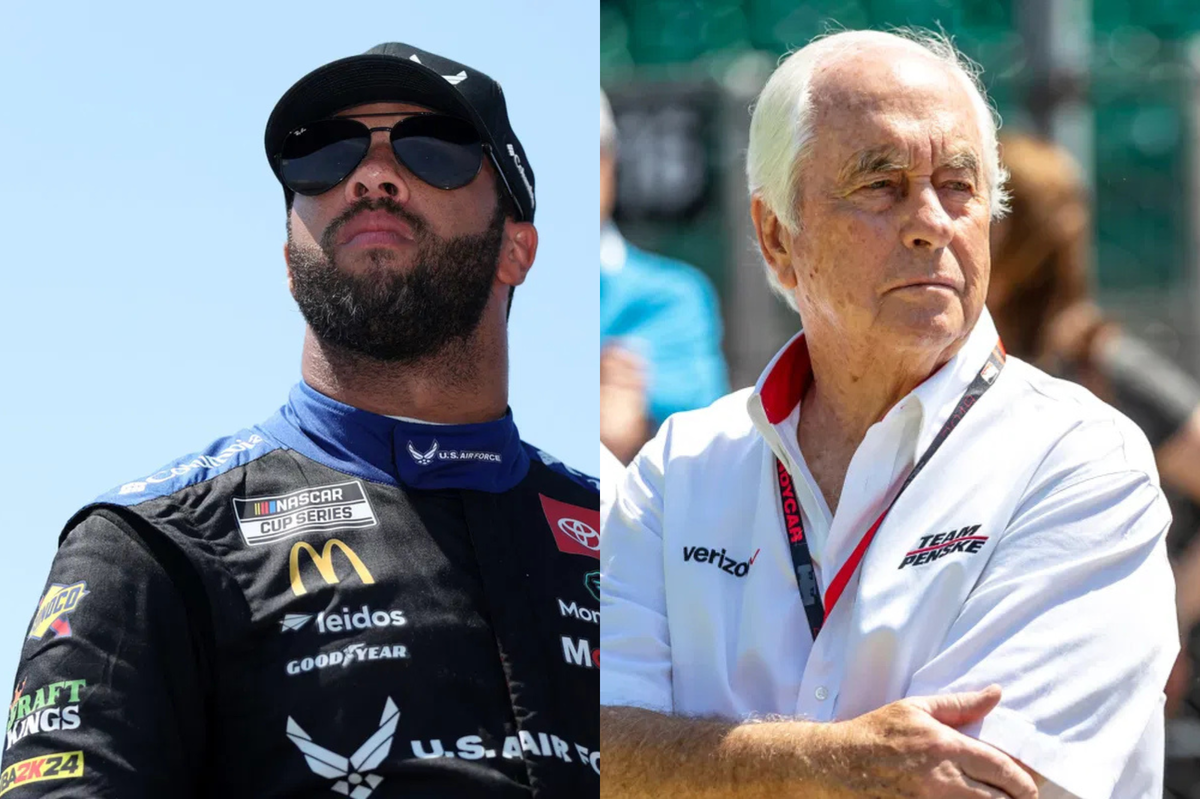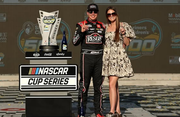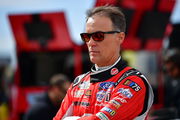
via Getty
DARLINGTON, SOUTH CAROLINA – AUGUST 31: Bubba Wallace, driver of the #23 U.S. Air Force Toyota, looks on during qualifying for the NASCAR Cup Series Cook Out Southern 500 at Darlington Raceway on August 31, 2024 in Darlington, South Carolina. (Photo by Meg Oliphant/Getty Images)

via Getty
DARLINGTON, SOUTH CAROLINA – AUGUST 31: Bubba Wallace, driver of the #23 U.S. Air Force Toyota, looks on during qualifying for the NASCAR Cup Series Cook Out Southern 500 at Darlington Raceway on August 31, 2024 in Darlington, South Carolina. (Photo by Meg Oliphant/Getty Images)
At Atlanta in 2022, NASCAR’s only Black full-time driver raced with a “Black Lives Matter” paint scheme and wore a shirt that read, ‘I Can’t Breathe.’ And this came after a stronger threat came to young Bubba Wallace and was proven baseless. We are all aware of the 2020 ‘Noose incident,’ right? NASCAR got protective about their driver, and the FBI was involved in finding the reasons. The flying of Confederate flags was banned by NASCAR that year onwards.
While many fans wanted to keep this custom running, some stood against NASCAR’s decision to fly Confederate flags just outside the tracks. And this was the mixture of emotions for two events, one which happened with Bubba, and the other was the heinous act against George Perry Floyd Jr. And, Wallace was at the center of the line that the sport had drawn.
“The time is now to listen, to understand and to stand against racism and racial injustice,” NASCAR President Steve Phelps declared on June 10, 2020, before banning the tradition completely. And, even if Bubba was not quite vocal about it back then, he recently used four decisive words to address how he felt about the change.
ADVERTISEMENT
Article continues below this ad
A Sport Changed, but Some Questions Never Fade
For many, Bubba Wallace became a target of criticism as well as a symbol of progress when the sport outlawed the Confederate flag. But, the real question is, what were the thoughts of the other drivers around the ban of a long-running tradition. And Bubba has answers. Speaking about fellow drivers’ reactions, Wallace said, “I honestly can’t say that they didn’t want it banned. So I didn’t really know their viewpoint, but I think we all came together as one. I think that’s all you can ask for in a sport. And as for the ones who didn’t want the ban had never come forward or shown their displeasure.” This clearly shows how the NASCAR family operates. And then, Bubba summed up his own viewpoint about the same.
“I can honestly say the sport has been way better without it,” Bubba said, summing up his sentiments. Even NASCAR’s official X handle posted about it with the caption, “The presence of the Confederate flag at NASCAR events runs contrary to our commitment to providing a welcoming and inclusive environment for all fans, our competitors, and our industry. Bringing people together around a love for racing and the community that it creates is what makes our fans and sport special. The display of the Confederate flag will be prohibited from all NASCAR events and properties.” But then we get to the interesting topic: What does he feel about the ‘Noose incident’?
View this post on Instagram
When Wallace was questioned about the incident and who put the noose, he dealt with it quite maturely. “It was there years before we got there, and it’s just that once that I had that garage. It is still a topic of discussion to this day. It is wild. If you see my twitter mentions it’s ‘Bubba finished third boos or noose?’ It was there before I got there. It was just one in a million coincidences that I had that garage stall, and in fact it was tied in a fashion like that. It could’ve been small. It doesn’t matter. So it is what it is,” Bubba Wallace said, with his voice resonating with the findings of the now-NASCAR President Steve Phelps.
What’s your perspective on:
Bubba Wallace: A symbol of progress or a target of controversy in NASCAR's evolving landscape?
Have an interesting take?
Addressing the long-standing question, Bubba Wallace said what he actually realized about the situation escalating. “It sucks that the sport was put in that situation, that I was put in that situation, my team was put in that situation. But we’ve learned a lot about who we are as a sport and who we are as competitors,” he said. Realizations apart, what had Bubba emotionally gone through?
Addressing this, Bubba said, “A year or two after that was rough. I went from being one of the I wouldn’t say most liked but favorable drivers, but now it’s just been the booze and stuff, but that’s okay.” And he has a very interesting approach towards fans booing during races. “I’m not a person that boos other teams, cause I’m just in the sports world myself but fans do what they want. So booing is a part of sports in general. It was the week of Talladega, it was like a light switch. I was like ‘Woah! Holy s—, I didn’t ask for this.’ And they all were making noise, and I have always been told that when they stop making noise is when it’s worse,” the 23XI Racing driver said. As his team, 23XI Racing, keeps becoming better, he establishes himself as a serious Cup series contender.
But, the confederate flag ban was a step, not just towards a more inclusive sport, but to something bigger.
Trending
NASCAR’s Confederate flag ban reshaped the sport’s future
For many years, NASCAR was viewed as a sport with strong Southern roots, which had a fervent fan base and kept the league at odds with its commercial appeal. Some feared it would alienate devoted followers, while others saw it as an essential step toward inclusivity. The NASCAR chairman at the time, Brian France, said the series was “working with the industry to see how far we can go to get that flag to be disassociated entirely from our events.” But was the move all a moral strategy?
The Confederate flag prohibition was a calculated commercial decision made by NASCAR, not just a moral one. Large corporate sponsors were hesitant to fully support the sport for years because of worries about how it would be perceived. By demonstrating a dedication to inclusion, the ban brought in new sponsorship agreements and increased revenue. In order to assist NASCAR in reaching a wider audience, media partners also embraced the opportunity to reframe the sport’s narrative to emphasize diversity initiatives.
ADVERTISEMENT
Article continues below this ad
As more businesses see NASCAR as a forward-thinking venture, sponsorships have increased. Talents like Rajah Caruth, Jesse Iwuji, and Daniel Suárez have been produced under the ‘Drive for Diversity’ program, demonstrating how the sport is evolving. This change is demonstrated by Michael Jordan’s 23XI Racing, which draws in investors who previously disregarded NASCAR.
Together with Denny Hamlin, Jordan’s participation demonstrated NASCAR’s commitment to accepting a wide pool of investors. This development was further supported by Trackhouse Racing, which Pitbull and Justin Marks co-founded and aimed to attract younger, more varied spectators. NASCAR demonstrated that its transition was not merely symbolic but a sustained commitment by making significant efforts to diversify leadership at the executive level.
Thereafter, attempts were made to develop a more varied driver pipeline. Despite the slow pace of change, these programs show the sport’s dedication to providing minority drivers with genuine opportunity, marking a departure from its traditionally homogenous talent pool. “That was a huge pivotal moment for the sport. A lot of backlash, but it creates doors for the community to come together as one.” Wallace said at that time.
ADVERTISEMENT
Article continues below this ad
Five years after the flag ban, NASCAR has changed its ownership structure, talent development, and financial model, demonstrating that advancement, not nostalgia, will shape the organization’s future.
Have something to say?
Let the world know your perspective.
ADVERTISEMENT
ADVERTISEMENT
ADVERTISEMENT
ADVERTISEMENT







Bubba Wallace: A symbol of progress or a target of controversy in NASCAR's evolving landscape?